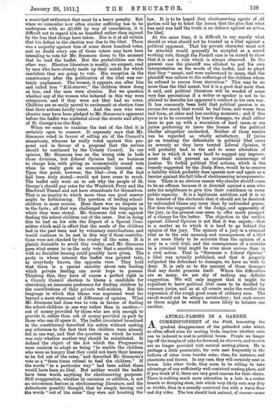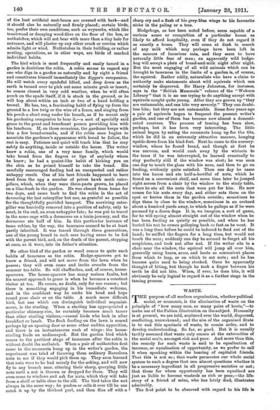ANIMAL-TAMING IN A GARDEN.
ACORRESPONDENT of the Field, lamenting the gradual disappearance of the pollarded oaks which so often afford sites for nesting birds, inquires whether owls can be induced to nest in artificial boxes. People no longer lop off the boughs of oaks for firewood, he observes, and so owls are no longer provided with natural nesting-places. He is perhaps a little pessimistic, for owls nest frequently in the hollows of other trees besides oaks ; elms, for instance, and chestnuts and thorns. In any case, they will certainly nest in boxes. Like other birds, they seem to be willing to take advantage of any sufficiently well-contrived nesting-place, and if you think of it, there are very good reasons for their choice. There is nothing much more attractive in a hole in a rotten branch or decaying stem, into which very likely rain may drip or trickle, than in a soundly contrived box with a warm floor and dry sides. The box should look natural, of course—some
of the best artificial nest-boxes are covered with bark—and it should also be naturally and firmly placed ; certain birds, too, prefer their own conditions, such as wrynecks, which like touchwood or decaying wood-fibre on the floor of the box, or nuthatches, which will not bear with more than a tiny bole for entrance, and will plaster up any other crack or crevice which admits light or wind. Nuthatches in their building, or rather nesting, operations, as in other ways, are birds of marked individual habits.
The bird which is most frequently and easily tamed in a garden is doubtless the robin. A robin seems to regard any one who digs in a garden as naturally and by right a. friend and constitutes himself immediately the digger's companion.
He will watch every spadeful lifted, and drop down as the earth is turned over to pick out some minute grub or insect; he comes closest in very cold weather, when he will often perch on the spade itself, if it is stuck in the ground, or he will hop about within an inch or two of a hand holding a trowel. He has, too, a fascinating habit of flying up from the ground to a low twig or the wire of a fence, and singing from his perch a short song under his breath, as if he meant only his gardening companion to hear it,—a sort of specially said grace to the great and beneficent person providing him with his luncheon. If, on these occasions, the gardener keeps with him a few bread-crumbs, and if the robin once begins to associate the gardener's appearance with bread to follow, the rest is easy. Patience and quiet will teach him that he may safely do anything, inside or outside the house. The writer knew a robin, one of a very tame family, which would take bread from the fingers or lips of anybody whom he knew; he had a quaint-like habit of kicking you on the chin as he poised himself to take the bread. His carefully encouraged feeding had an unexpected and rather unhappy result. One of his best friends happened to have bred from the egg a number of privet hawk moth cater- pillars, which, when they were three-parts grown, he placed on a lilac-bush in the garden. He was absent from home for two days, and came back to find the robin in the act of devouring the last caterpillar but one, as grateful as possible for the thoughtfully provided banquet. The surviving cater- pillar was hurriedly removed into a position of safety, only to meet, in the end, an even unhappier fate ; he was put to travel in the same cage with a dormouse on a train-journey, and the dormouse ate half of him. In this particular instance of tame robins, by the way, the tameness seemed to be at least partly inherited. It was traced through three generations, one of the young brood in each case having come to be fed with the parent bird, and, on the death of the parent, stepping at once, as it were, into its father's situation.
No other bird of the garden or wood comes to quite such habits of tameness as the robin. Hedge-sparrows get to know a friend, and will not move from the lawn when he passes; they will even come and invite crumbs from the summer tea-table. So will chaffinches, and, of course, house- sparrows. The house-sparrow has many serious faults, but his nearest approach to grace is when he becomes a constant visitor at tea. He comes, no doubt, only for one reason ; but there is something engaging in his immediate welcome, and in the confident way he cocks his head and hops round your chair or on the table. A much more difficult bird, but one which can distinguish individual acquaint- ances, is the starling. When a, starling has appropriated a particular chimney-rim, he certainly becomes much tamer than other starling visitors,—casual birds who look in after breakfast or lunch. The flock feeding on the lawn is scared perhaps by an opening door or some other sudden apparition, and there is an instantaneous rush of wings : the house- starling feeds on undismayed. But the garden bird which comes to the prettiest stage of tameness after the robin is without doubt the nuthatch. When a pair of nuthatches first came to the cocoanuts hung up in the writer's garden, the experiment was tried of throwing them ordinary Barcelona nuts to see if they would pick them up. They soon learned that nuts were to be had merely for the asking, and will now fly to any branch near, uttering their sharp, querying little note until a nut is thrown or dropped for them. They will even come to windows and ask for nuts, which they will take from a shelf or table close to the silL The bird takes the nut always in the same 'way; he pushes or rolls it over till he can catch it up by the thickest part, and then flies off with a
sharp cry and a flash of his grey-blue wings to his favourite niche in the paling or a tree.
Hedgehogs, as has been noted before, seem capable of a curious sense or recognition of a particular house as likely to afford hospitality, even if they do not regard it as exactly a home. They will come at dusk in search of any milk which may perhaps have been left in the saucers of luxurious cats, and they seem to have naturally little fear of man; an apparently wild hedge- hog will accept a plate of bread-and-milk night after night. But the most engaging of all wild animals which can be brought to tameness in the limits of a garden is, of course, the squirrel. Rather oddly, naturalists who have a claim to authority make statements about wild squirrels which can certainly be disproved. Sir Harry Johnston, for instance, says in the "British Mammals" volume of the "Woburn Library" that it is no use trying to do anything except with squirrels caught quite young. After they are grown up "they are untameable, and can bite very severely." They can doubt- less bite; but they are not untameable. Some four years ago a pair of squirrels began to frequent the present writer's garden, and one of them has become now almost a domesti- cated creature. The process of taming has been slow, perhaps, but it has been very interesting. The little animal began by eating the cocoanuts hung up for the tits, which he did in an extremely attractive manner, hanging upside-down from his hind-feet. Next he came to the nursery- whidow, where he found bread, and though at first he was nervous, and would rush away by the wistaria to the trees if be was interrupted, he learned eventually to stay perfectly still if the window was shut; he was seen one day to touch the glass with his nose, and then to go on feeding, evidently quite satisfied. Then one day he came into the house and ate half-a-bowlful of nuts, which he found on a convenient shelf, and some time later he jumped right across from a chair by the window to the study table, where he ate all the nuts that were put for him. He now comes for his nuts every day, and either eats them on the spot or buries them in the garden outside; sometimes he digs them in close to the window, sometimes in an orchard about a hundred yards away, to which he gallops as if he were pursued by a dozen dogs. It is, we imagine, a sort of game, for he will spring almost straight out of the window when he has been feeding as quietly as possible, and when he has buried his nut he comes galloping back as fast as he went. It was a long time before he could be induced to feed out of the hand; he sniffed the fingers for a long time, but would not touch the nuts; suddenly one day he seemed to forget all his suspicions, and took nut alter nut. If the writer sits in a chair near the window, the squirrel will jump all over him, generally using knees, arms, and boots as convenient places from which to leap, or on which to eat nuts ; and he has become quite used to being stroked. Once he apparently thought of biting, but though he took a finger between his teeth he did not bite. When, if ever, he does bite, it will obviously be only logical to regard it as a further stage in the taming process.























































 Previous page
Previous page